Index 1) Characteristics of Paint
2) Types and Brands of Paint
3) Pot Types
4) Applying the Paint
1) Characteristics of Paint
2) Types and Brands of Paint
3) Pot Types
4) Applying the Paint
1) Characteristics
of Paint

Translucency
Some paints give a solid opaque effect but others tend to be slightly
translucent. This is a very bad thing (unless you are going for a particular
effect). Ten years ago a lot of Citadel paints, particularly reds and
yellows tended to suffer from this, although they now seem much better.
Most paint will cover OK on pale colours but not on dark colours. Although
you can get round this by applying a pale coat first, it is better to
buy a quality paint.
Liquidity
Paints are composed of pigment and medium. The pigment is the colour,
and the medium is colourless gunk that binds it. Suitable paints for modelling
should not be too solid, otherwise a lot of water is required to make
them liquid enough to paint with. In this case the coverage is then often
not too good, as the paint you are applying contains mainly water rather
than acrylic medium.
Coverage
Some paints, although opaque, are difficult to apply to unpainted surfaces,
as they tend to recoil, particularly from plastic. This is difficult to
explain, but the paint seems to be repelled by the surface, as if trying
to paint on wax. Plastic surfaces are particularly prone to this, even
if washed with detergent to remove surface grease.
Texture
I like paint to have a smooth, very slightly satin finish. Some supposedly
matt paint become glossy if the pigment settles to the bottom of the medium.
Other paints are so matt that the finish looks almost chalky.
Changing colour while drying
This is very bad, and a real problem for shading. When you have jsut applied
the paint it looks fine, but when it dries and changes colour (usually
darker), you end up with a distinct boundary in colour where there shouldn't
be one. This tends to happen with cheaper paints, where the pigment has
a tendency to separate from the medium.
Batch consistency
If you buy the same colour paint, will both pots match. Artist's colours
are very good for this, but many of the smaller manufacturer's aren't.
Years ago Games Workshop used to be particularly poor at this but have
since much improved.
Colour density
Some of the 'craft' acrylics don't seem to have a lot of pigment in them
for the volume of paint, which may well be why they are cheaper. When
mixed with other paints they don't alter the overall colour as much as
you would expect. Also you seem to use more.
2) Types and Brands of Paint

Mixing paints
All the following paints can be mixed together without problems as all
are water based. Sometimes mixing two types of paint can compensate for
specific deficits found in one of the types.
In approximately descending order of price.....
Artist's Acrylics (Rowney/Winsor & Newton)
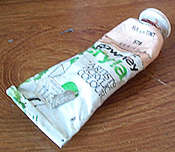 Pot
type: Squeezable Tube
Pot
type: Squeezable Tube
Pot price: Varies
Pot size: Varies
Pence/ml: About 10p (depending if 'student' or 'artist' range)
Artist's acrylics come in tubes, and have a different medium to modelling
acrylics. because they are designed to be used on porous surfaces rather
than plastic and metal. Their batch consistency is excellent, and there
is plenty of pigment. The paint lasts almost forever in the tube without
drying out. However, their thick consistency needs dilution when used
on a model, which can result in problems of poor coverage and slight lumpiness
The two artist's colours which I use are a flesh tone, which I bought
because Games Workshop didn't do a suitable colour at the time. I also
have a rich red colour called 'Naphthol Crimson', which is fantastic for
producing dark colours to shade red. I have yet to find a red paint from
a modelling range which has the colour and richness of pigment that some
reds from artists' ranges have.
Games Workshop
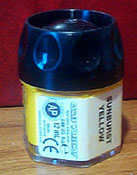
Pot type: Screw-top pot
Pot price: £1.50
Pot size: 12ml
Pence/ml: 12.5
Games Workshop paint is the most expensive of the paints reviewed
here, but it is also my favourite. The consistency is just right.
GW paints used to suffer from poor coverage, particularly with reds
and yellows, but they now perform extremely well. There also used
to problems with batch consistency, but these have largely gone.
The only problem is that they seem to change the names and colours
in their range relatively frequently which can make it difficult
to replace colours.
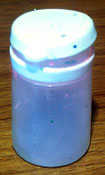 The
only problem with GW paint is the appalling pot design. Once it
has been opened and a little paint has hardened then they are almost
impossible to fully seal, which is a particular problem for the
inks which are more liquid than the standard paint. I always decant
them into the old design of pots, which were vastly superior. The
only problem with GW paint is the appalling pot design. Once it
has been opened and a little paint has hardened then they are almost
impossible to fully seal, which is a particular problem for the
inks which are more liquid than the standard paint. I always decant
them into the old design of pots, which were vastly superior.
|
Chromacolour Craft Paint
|
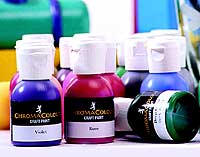 Pot
type: Squeezable Pot Pot
type: Squeezable Pot
Pot price: £2.55
Pot size: 30ml
Pence/ml: 8.5
I haven't tried these yet - I saw Zulu's post about them on the
Vietnam Fields of Fire boards, and was intrigued. He rates them
very highly so I'm going to give them a go.
You can see their range of 60
colours and order online
|
Humbrol
|
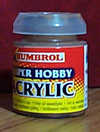 Pot
type: Snap-top pot Pot
type: Snap-top pot
Pot price: £1.00
Pot size: 12ml
Pence/ml: 8.3
The range of colours contains a lot of military drab tones, which
complement Games Workshop's more saturated selection well. The pot
lids just press down, so be careful when travelling with them.
These are fairly expensive, but consistency, texture, opacity are
all good.
|
Tamiya
|
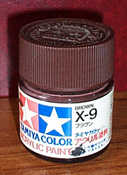 Pot
type: Screw-top pot Pot
type: Screw-top pot
Pot price: ?
Pot size: ?
Pence/ml: ?
I'm not particularly keen on Tamiya paints because of the medium
and the pot design. The screw top lids tend to get stuck - the whole
glass pot once disintegrated on me when forcing it open. The medium
also tends to evaporate off quite quickly, and the paint in the
pot goes hard very fast. Finally the paint also seems to cling to
the brush hairs if you paint for a reasonably time without washing
them out which probably damages the brushes.
Tamiya do however, have some excellent metallics, particularly
their copper which is incredibly bright and metallic, but I would
definitely recommend decanting the paint out of the pots.
|
Vallejo Model Color
|
 Pot type: Inkdropper
Pot type: Inkdropper
Pot price: £1.40
Pot size: 17ml
Pence/ml: 8.2
Vallejo would be my choice as a budget substitute for Humbrol and
Games Workshop paint. It has a slight tendency to dry a chalky matt
texture, and I prefer a pot that I can actually dip a brush in.
Vallejo is not as widely available as Humbrol or GW, but can be
found at most large wargames shows.
Like Humbrol, the range contains many subdued, 'military' colours.
|
Anita's Craft Paint
|
 Pot
type: Squeezable Pot Pot
type: Squeezable Pot
Pot price: £1.50
Pot size: 59ml
Pence/ml: 3.8
This stuff is cheap, but I'd never buy it again because it's rubbish
for model painting. There is very little pigment in it (so when
painting scenery you have to use twice as much), it doesn't cover
properly because it recoils and it's also fairly transluscent.
|
Sandtex Tester Pot
|
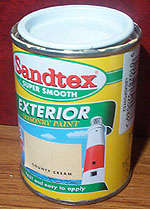 Pot
type: Traditional Tin Pot
type: Traditional Tin
Pot price: £1.39
Pot size: 125ml
Pence/ml: 0.9
Sandtex and other masonry paint is an absolute staple of mine for
scenery painting. The paint is outstandingly cheap, covers well
and when it dries it is very hard and difficult to chip. The only
problem is the restricted range of colours (basically shades of
beige). If you are using a textured paint then this is also excellent.
Some masonry paint comes with texture already in it, but if it doesn't
then the thick binding medium makes it very suitable for adding
sand anyway.
Do-it-all make tester pots of smooth black masonry paint, which
is a cheap way to paint bases.
|
3) Pot Types

|
Qualities to look for:
- Does it seal properly (leakage and drying
out)?
- Is it easy to undo the top?
- Does paint dribble down the sides of the pot or into grooves in
the cap when open?
- Does the lid become damaged by taking it on and off?
- Tip:Paint the tops of your
paint pots, so you can identify them easily in the box.
|
Screw-top pot
Inconvenient to undo. Frequently jam with hardened paint. Difficult to
get a good seal unless strongly tightened - then it jams even more easily.
I once tore a glass Tamiya pot in half when trying to get the top off
with a wrench, because the lid was bonded so strongly to the glass. I often
decant paint from these into old film canisters, which seal beautifully
although they are a bit on
the large side.
Snap-top pot
My favourite type. Occasionally requires cleaning out, mainly to prevent
leakage.
Inkdropper
No drying out problems, but a bit inconvenient to use - first you have
to unscrew the lid, and then there it requires squeezing some out onto
a palette, which results in some wastage. Impossible to stir if it settles
and separates, you'd have to cut the pot open and decant it.
Traditional Tin
The old fashioned metal paint container with the press on lid. These are
a bit of a nuisance because they usually need levering open with a screwdriver
or similar. Then, when they have been used a bit, paint will build up
around the top of the jar and the lid won't seal properly. To make matters
worse dislodging the paint often dents and bends the thin edge, so even
when clean it still won't fit properly.
Squeezable pot
Good on a spillage point of view, but you have to squirt some onto a palette
to use it, and the amount that comes out is difficult to control.
Squeezable tube
Paint can be taken directly from the mouth of the open tube with a brush,
so you don't have to put any on the palette. No drying out problems, but
only an option with firmer paint, ie artist's colours.
4) Applying the Paint

A common mistake is not to add enough water to the paint. Paint used
neat from the pot will be too thick. Undiluted paint will give a
lumpy uneven surface and will also dry quicker, making shading techniques
difficult. It will also not flow smoothly from the brush, making it harder
to place the paint exactly where you want it on the figure. As artist's
acrylics are thicker than modelling paint, adding water is even more important
with these.
Use as large a water container as practical. Think jam jar and not
egg cup. If you use a small water container then it will rapidly become
contaminated with paint, and as the water will be used to dilute other
colours, it will begin to contaminate them. Change your water regularly,
after every few hours of painting. If you have been using it to wash PVA
or metallic paint out of a brush, then it is worth changing it straight
away. PVA, even highly diluted, will not do brushes any good if allowed
to dry on them, and even very small amounts of metallic paint will contaminate
dark colours with a minute 'glitter' effect. You could also consider using
two water pots, either metallic and non-metallic, or clean and dirty (one
for the first brush rinse and one for the final rinse).


 Pot
type: Squeezable Tube
Pot
type: Squeezable Tube 
 The
only problem with GW paint is the appalling pot design. Once it
has been opened and a little paint has hardened then they are almost
impossible to fully seal, which is a particular problem for the
inks which are more liquid than the standard paint. I always decant
them into the old design of pots, which were vastly superior.
The
only problem with GW paint is the appalling pot design. Once it
has been opened and a little paint has hardened then they are almost
impossible to fully seal, which is a particular problem for the
inks which are more liquid than the standard paint. I always decant
them into the old design of pots, which were vastly superior. Pot
type: Squeezable Pot
Pot
type: Squeezable Pot Pot
type: Snap-top pot
Pot
type: Snap-top pot Pot
type: Screw-top pot
Pot
type: Screw-top pot Pot type: Inkdropper
Pot type: Inkdropper Pot
type: Squeezable Pot
Pot
type: Squeezable Pot Pot
type: Traditional Tin
Pot
type: Traditional Tin